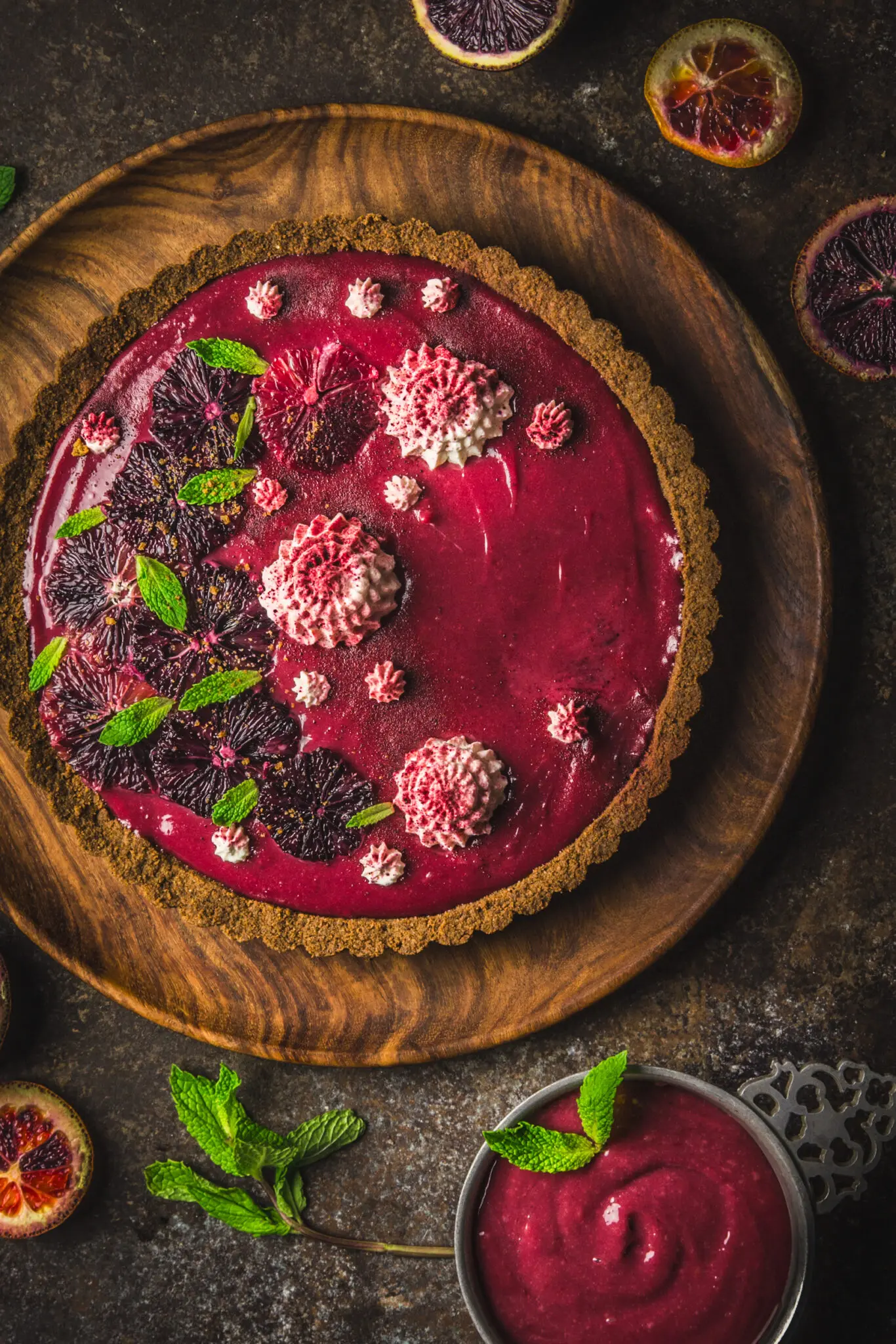
When blood oranges are in season, we just can’t get enough of them so when we found a local shop selling a big bag of them for under 5 bucks, we knew we couldn’t pass them up. But what do you do when life gives you lem… oranges? Make curd!
We are legit curd crazy in this house. Curds with knives, they call us (no one calls us this). Lemon curd is pretty much a bi-monthly event in our kitchen. We’ve made blueberry-lemon curd, strawberry curd, even rhubarb curd. In fact, it was our experience with rhubarb curd that led us to add an extra ingredient, hibiscus, to our blood orange version (more on this later in the article).
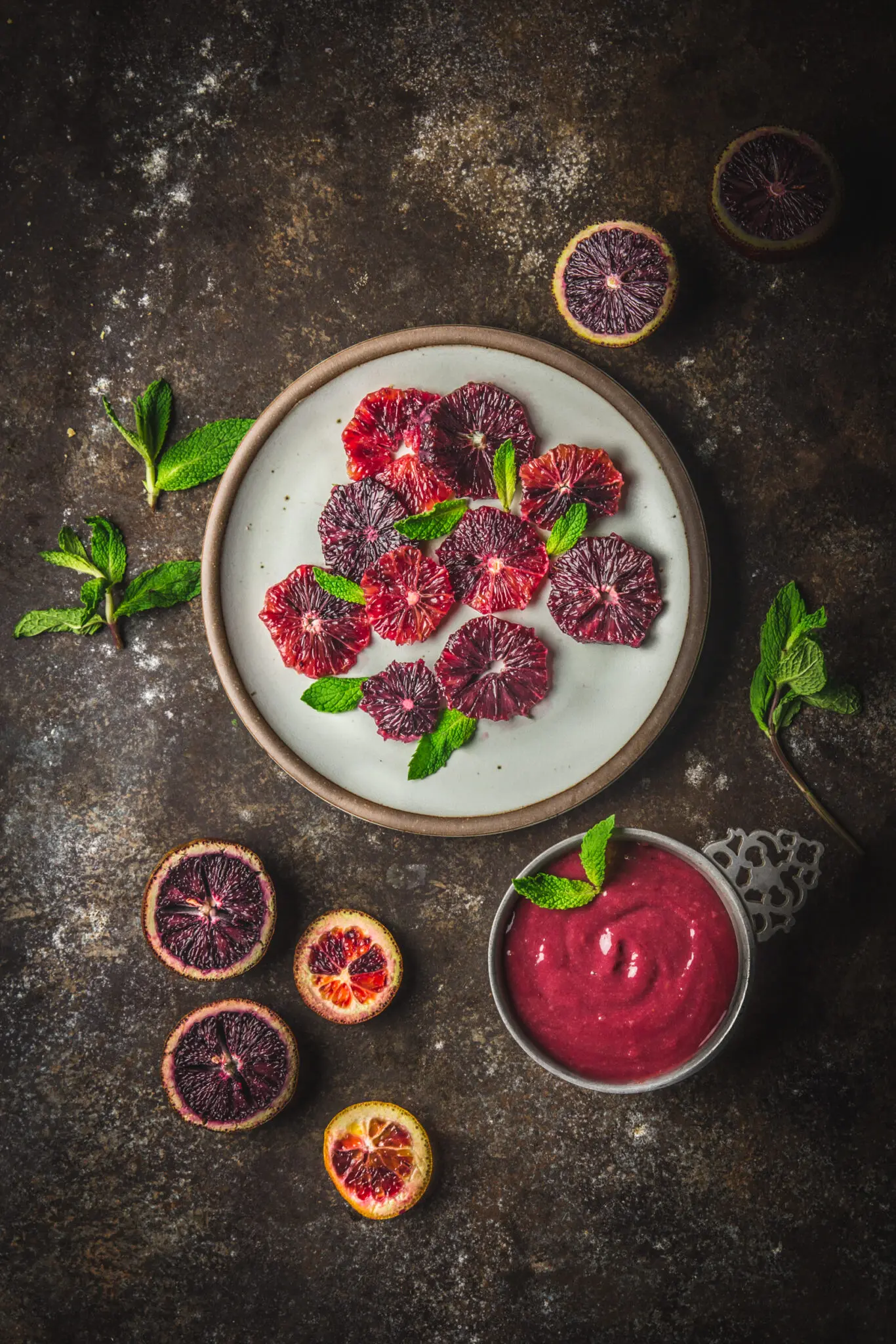
The Curd Story
So what exactly is “curd”? You can think of it as kind of a cross between a jam and a custard. Usually but not exclusively made with citrus, a curd is a slow cooked mixture of tart fruit juice and sugar, thickened by egg yolks, and often butter. You can use it as a spread on toast or cookies, as a filling for pies and tarts, or as a drizzle over ice cream or cake. Mass produced varieties tend to be on the overly-sweet side for our tastes. While still sweet, we like our curd to have a sharp citrusy bite, so it really tastes like fruit. Blood oranges have an intense orange flavor, and blood orange curd delivers that flavor beautifully.
Making the Curd
There are a lot of different methods for making curd but we’ve found that the method of creaming all the ingredients together in a mixer before cooking them slowly and gently in a saucepan is pretty much foolproof.
The first step is to zest the oranges. The skin on citrus fruit contain oils that hold loads of flavor, almost more than than the juice, so we don’t want to waste it. The easiest way to get the zest is with a rasp-style grater (one of our all-time favorite kitchen tools). Then juice the oranges until you have a full cup of juice (about 8 small oranges). Note: if you don’t have enough blood orange juice, you can supplement with regular oranges, as needed.
Add the zest to a mixing bowl with the butter, sugar, salt and corn starch and beat it all together for a couple of minutes until the butter is lighter in color. Then add the eggs one at a time, beating the mixture thoroughly between each addition, and scraping down the sides of the bowl, as needed. Mix in the juice and try not to panic because it’s going to look like a crazy curdled mess. Add the curd mixture to a medium (2 or 3 quart), heavy-bottomed saucepan and stir in the hibiscus petals.
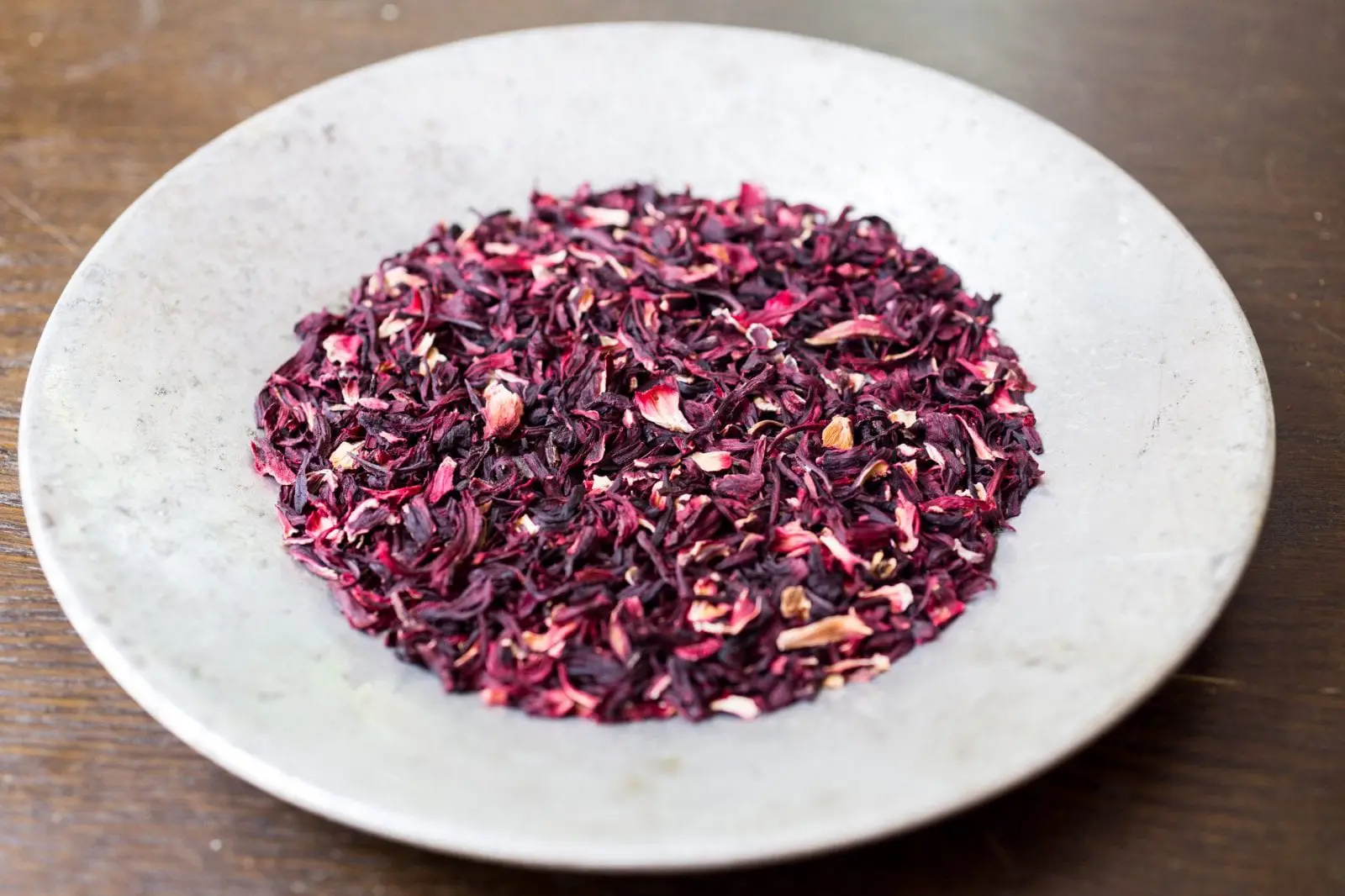
Using Hibiscus Flowers
So let’s pause here for a minute to talk about what hibiscus is and why it works so well in this recipe. Hibiscus, also known as rose mallow, is a flowering plant belonging to the same family as cocoa and cotton. The dried flowers are often used to make tea and you can buy them at many larger grocery stores, health food stores and the internet. We bought a big bag last year and have been using them in all sorts of way, in cocktails, syrups, glazes and more. Hibiscus has a deliciously tart, almost berry-like flavor and, even more importantly in this case, imparts a bright pink color.
Why is that important? Because, as we learned when we made rhubarb curd, the yellow egg yolks tend to mute the color of red and pink fruit, to the point where they can look drab and, well, not very exciting. Adding a good amount of hibiscus to the mix perks up the flavor of the oranges, but also brightens and deepens the color.
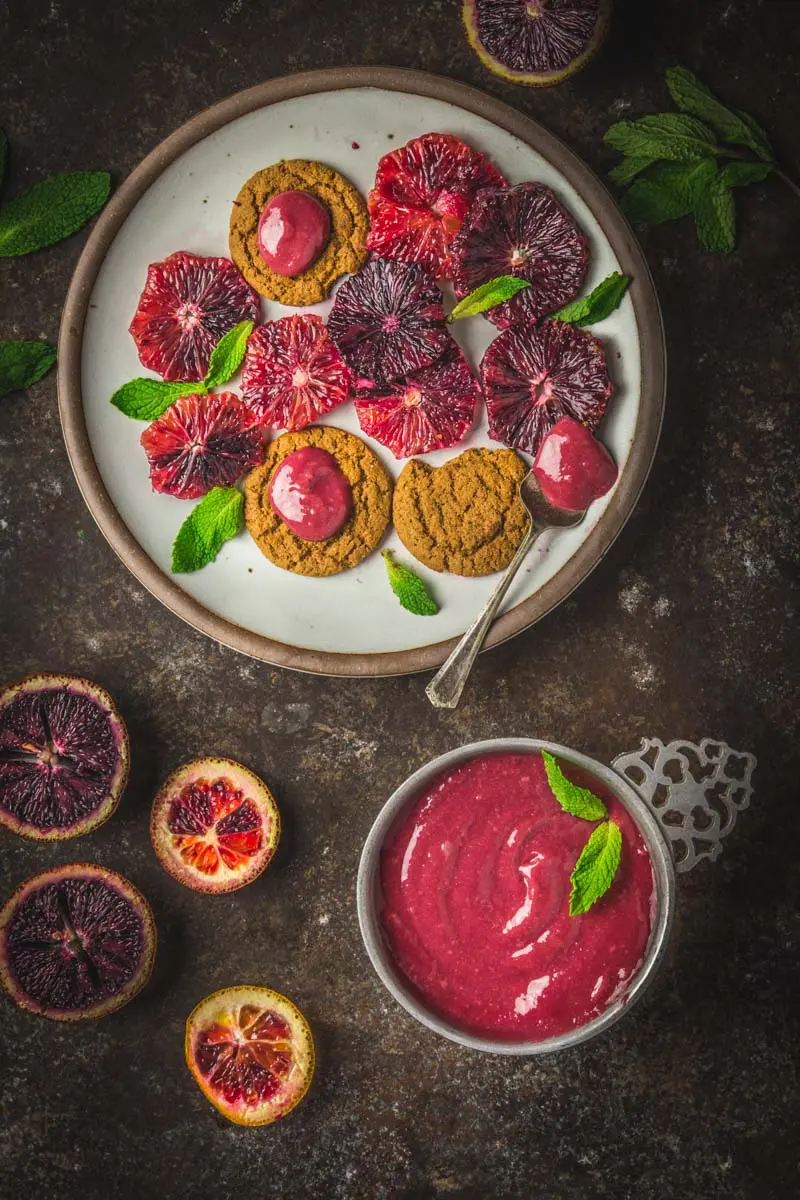
So back to the recipe: turn the heat under the sauce pan with the curd mixture and the hibiscus petals to medium-low and keep stirring as the mixture heats. It will go from curdled to emulsified pretty quickly, in 2 to 3 minutes, but keep stirring until the mixture thickens enough to coat the back of a spoon, 5 to 7 minutes longer (until the temperature is about 170ºF). Adjust the heat as needed to keep the curd just below a simmer, stirring the whole time it’s cooking.
Once thickened, transfer the mixture into a heatproof bowl and let it steep with the hibiscus petals for 10 minutes. Once it’s steeped and cooled a bit, pour it through a fine mesh sieve into another bowl or airtight container, pressing down on the solids to push the curd through and make sure to scrape the curd from underside of the strainer. Refrigerate the curd until ready to use (it will thicken more as it cools).
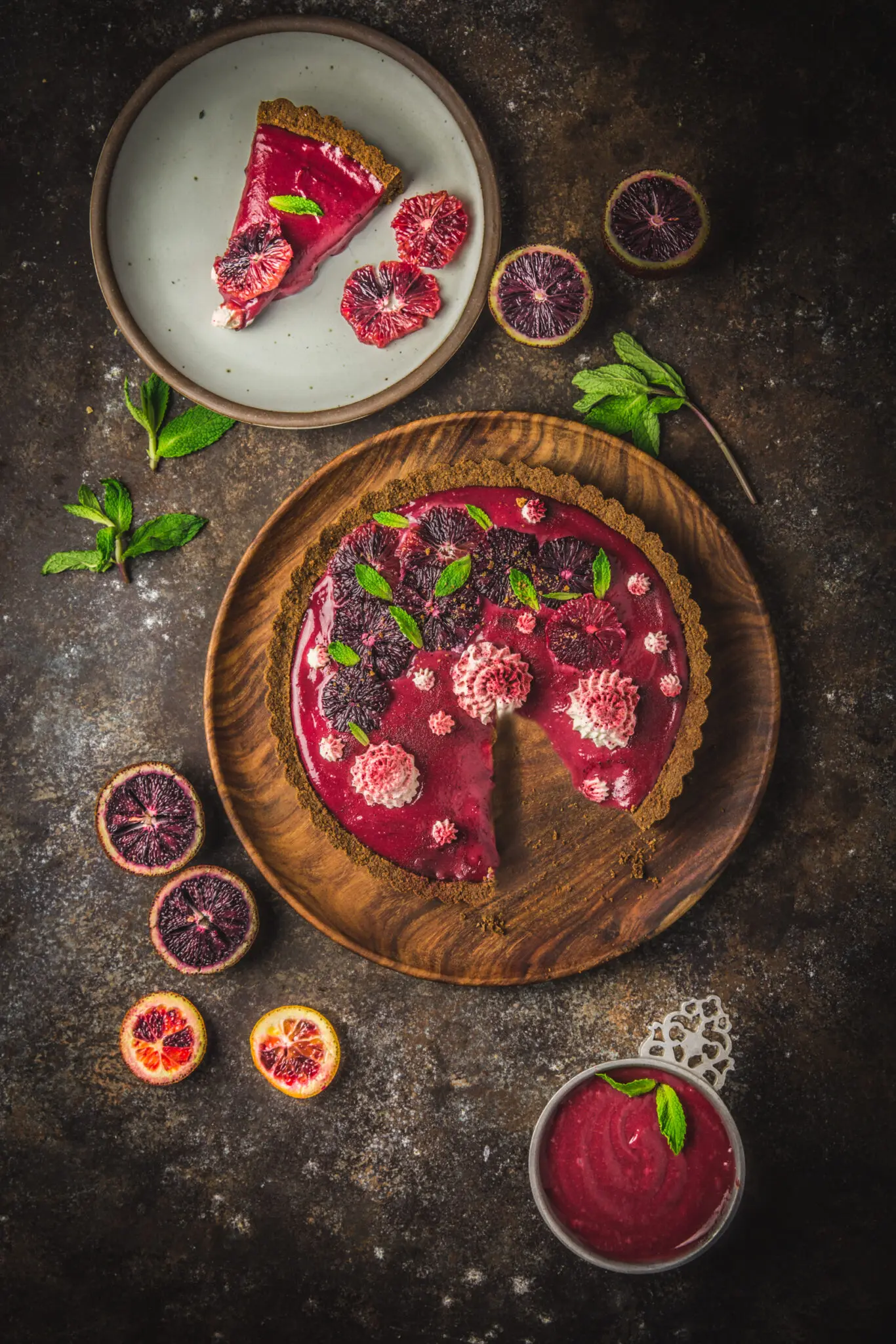
Now for the tart crust. We’ve long advocated for the use of a biscuit crumb base for tarts and similar filled desserts, and most often this involves pre-baking a crust made with graham crackers, butter, sugar, and a little salt. It’s way more reliable than making shortcrust pastry, and we much prefer the texture. For this tart, we wanted a flavor that complemented the sharpness of the filling — and found the answer in the warm, sweet notes of ginger snap biscuits.
About the Biscuit Base
Ginger snaps (also known in the UK as ginger nuts) are an old family favorite of Matt’s. Along with Bourbons, custard creams, Hob Nobs and digestive biscuits, they’re a great companion for a cup of tea. Here we’re using them instead of our usual choice, graham crackers, and they work in just the same way. Finely crumble the biscuits along with the butter, sugar and salt in a food processor until you get a mixture that’s still a little dry to the touch but which can be firmly shaped by hand into the sides and base of the tart pan. We used a 9-inch round pan but you can use different shapes, just make sure you use a pan with a removable bottom so that you can easily lift the set tart off the base when you’re ready to serve it.
We like a generous layer of biscuit (our tart sides are around a half an inch thick), but be aware that the biscuits are likely to contain sugar, fat and rising agents, and the base may rise a bit as it bakes, so you can prick the base all over with a fork before you bake it if you want to control the expansion. Don’t worry if it happens though, it will settle back down as it cools.
Bake the shell on a foil-lined tray (you’re likely to get some butter drips) in the middle of your oven for around 12 minutes — you should not see any significant browning but the shell should feel set — and let it cool completely on a wire rack before filling with the curd. We decorated ours with some sliced blood oranges, mint, and a little piped whipped cream-mascarpone topping, but just a little sprinkle of confectioner’s sugar would be gorgeous as well. We recommend that you chill the tart in the fridge for at least half an hour before cutting it.
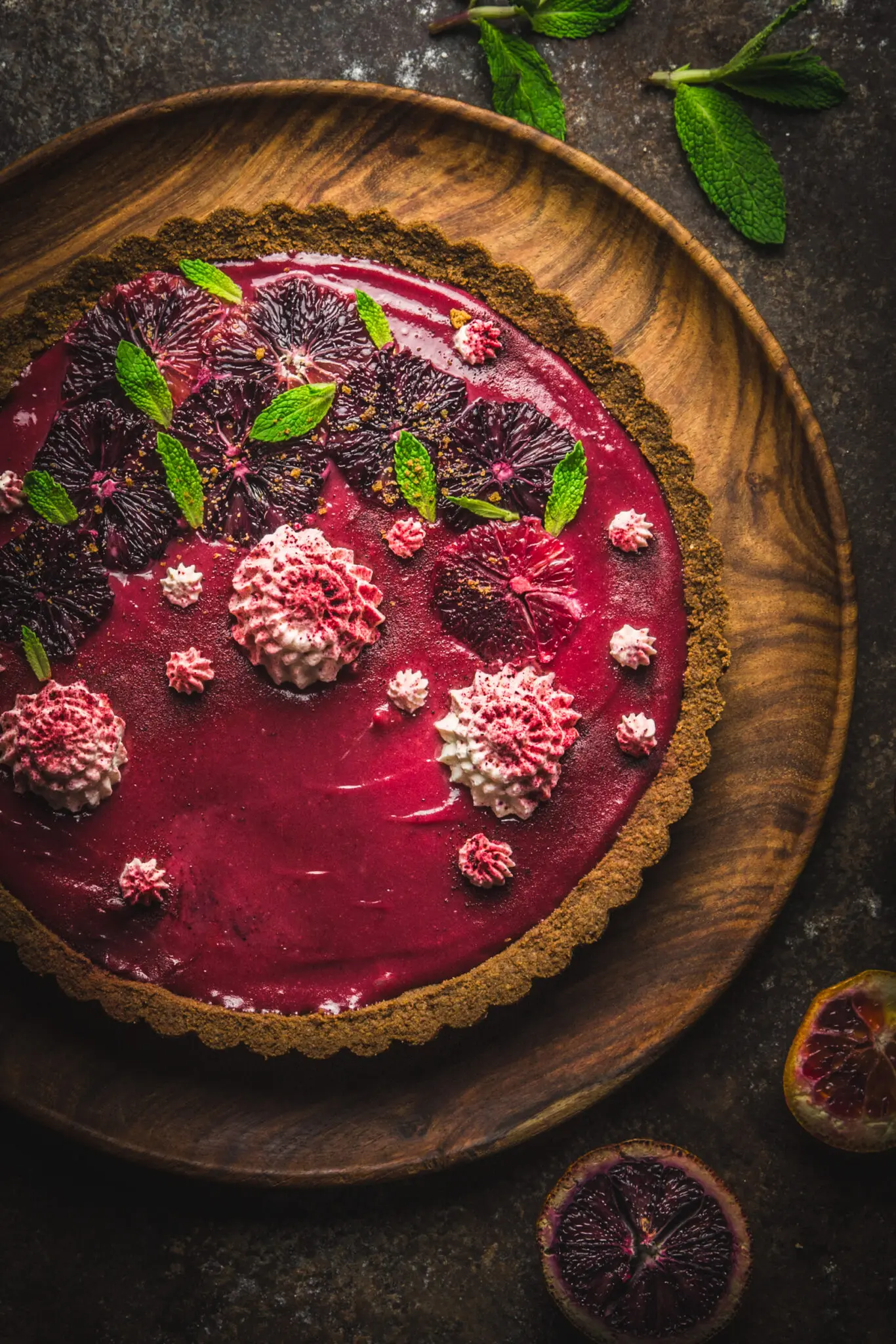
Blood Orange Curd Tart with Brown Butter Crust
Ingredients
For the crust:
- 6 tablespoons 85g unsalted butter, melted
- 2 cups finely ground gingersnap cookies (about 30 biscuits) (200g)
- 2 tablespoons light brown sugar
- 1/2 teaspoon ground ginger
- 1/2 teaspoon kosher salt
For the Blood Orange Curd:
- 8 tablespoons unsalted butter, room temperature 114g
- 2 tablespoons corn starch
- 1 cup 200g sugar
- 1/4 teaspoon kosher salt
- Finely grated zest from 4 blood oranges
- 4 large eggs
- 2 large egg yolks
- 1 cup blood orange juice about 8 oranges
- 1/2 cup dried hibiscus petals
For garnish (optional)
- 1 blood orange peeled and sliced
- 10 mint leaves
- 1 cup cold heavy cream whipped
Instructions
Make the Blood Orange Curd:
- In a large bowl (or a stand mixer fitted with the paddle attachment), beat the butter, corn starch, sugar, salt and orange zest until fully combined, about 2 min. Add the eggs and yolks one at a time, beating each until fully incorporated. Turn the mixer to low and stir in the blood orange juice. The mixture will look curdled, but it will smooth out as it cooks.
- Pour the mixture into a 3 quart heavy-bottomed saucepan and stir in the hibiscus petals. Cook over low heat, stirring constantly, until the mixture is thickened, about 10 minutes. The curd will thicken at about 170º F, or just below simmer. Remove from the heat and pour into a heat-proof bowl, scraping out any curd or hibiscus stuck to the bottom. Allow the hot curd to steep with the hibiscus petals for about 10 minutes, then pour it through the fine-mesh sieve into another bowl or an airtight container, pressing down on the solids to push the curd through. Make sure to scrape the curd from underside of the strainer. Allow to cool to room temperature, then cover the bowl with plastic wrap or seal the container, and refrigerate until chilled, at least an hour. Curd will get thicker as it cools.
For the crust:
- Preheat the oven to 350ºF and set a rack in the middle. Line a baking tray with foil and set it aside. To a medium bowl (or the bowl of the food processor if you ground the cookies up), add the cookie crumbs, melted butter, brown sugar, ginger and salt. Mix until completely combined, then tip into a 9-inch round tart pan with a removable bottom. Using your fingers or the bottom of a measuring cup, press the crumbs into the bottom of the pan and up the sides. Place the shell on the foil-lined tray and bake until the shell is set, about 12 minutes. Remove the pan and set it on a wire rack and allow the crust to cool completely before filling it.
- When the crust is cool, remove it from the tart pan and fill it with blood orange curd and chill it in the refrigerator until ready to serve. Garnish it with blood orange slices, dollops of whipped cream and mint sprigs, if desired. Tart will keep for 3 to 4 hours, filled with curd, but the crust may start to soften. Extra curd can be stored in the refrigerator in an airtight container for 3 to 4 weeks.
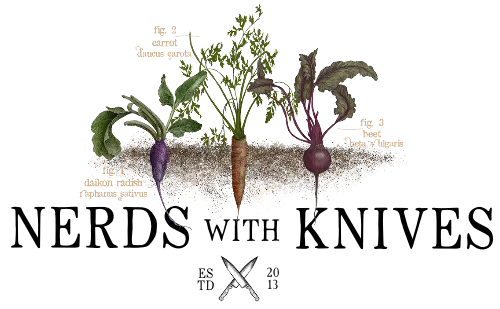

I can’t wait to try this. The beauty of the photographs is astonishing.
Thanks so much Rachel! I hope you like it as much as we did 🙂
My daughter made this for a dinner party last night. ..what a beautiful looking and tasting creation it is. She upped the ginger in the crust a bit. Both agreed you could cut down on the sugar in curd and crust. Overall, a wonderful new addition to special dessert repertoire- we too, are nerds for curds!!!
So glad you liked it! Interestingly enough, I think our blood oranges may have been a lot more tart than yours because our curd ended up very zippy! Not quite as much as lemon but close. I think they might vary greatly is sweetness.
The only good thing about this recipe are the pictures. The “curd” is awful, not a true curd at all, more like a quick pudding like mess, and the corn starch is very obvious, I should have known better..Flavor wise, ehhh Great idea, beautiful pictures, but the recipe it self leaves much to be desired.
Maybe you didn’t do it right
How did you color those beautiful perfect pipettes of whipped cream? Gorgeous!!
Thanks so much Lindsay! I used powdered dried hibiscus. It’s such a pretty color 🙂
I was so excited to try this.. And I’m so disappointed! I added more hibiscus and steeped it for 45 min.. Still way too brown. What filter did you use? Tastes decent but too sweet. Added fresh ginger to the crust instead of dry. Cut down the sugar so that was ok.. I’m sticking to cranberry curd if i want a pink tart. Straining the curd was a pain, not worth the effort Thanks for the lesson..